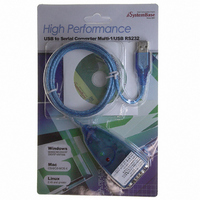20-151-0178 Rabbit Semiconductor, 20-151-0178 Datasheet - Page 35

20-151-0178
Manufacturer Part Number
20-151-0178
Description
CABLE CONVERTER RS-232 TO USB
Manufacturer
Rabbit Semiconductor
Datasheet
1.20-151-0178.pdf
(162 pages)
Specifications of 20-151-0178
Accessory Type
USB to RS232 Adapter
Product
Microcontroller Accessories
For Use With/related Products
Rabbit-based Boards
Lead Free Status / RoHS Status
Lead free / RoHS Compliant
Other names
20-151-0178
316-1181
316-1181
- Current page: 35 of 162
- Download datasheet (4Mb)
4.3.2 RS-232
You can select one of the following RS-232 channel configurations:
•
•
•
Serial port F is used for the first 3-wire channel. If you select two 3-wire channels, the second one will use
serial port D or E. A 5-wire channel will use serial port F for transmit/receive and serial port D or E for the
handshaking lines. Note that whether to use serial port D or E is a decision made when you are design-
ing/ordering your board. Once the board is built you cannot change which of these two serial ports to use.
The API function
The serial channel lines come out on J6 (see
provides the voltage output, slew rate, and input voltage immunity required to meet the RS-232 serial com-
munication protocol. Basically, the signals from the Rabbit 3000 are converted to RS-232 signal levels.
The polarity is reversed in an RS-232 circuit so that a +3.3 V input becomes approximately -7 V and 0 V is
output as +7 V. The RS-232 transceiver also provides the proper line loading for reliable communication.
The following table lists the different capabilities of the serial ports D and E. More information on these
serial ports can be found in the Rabbit 3000 Microprocessor User’s Manual.
An asynchronous port can handle 7 or 8 data bits. A 9th bit address scheme, where an additional bit is sent
to mark the first byte of a message, is also supported.
The RS-232 protocol is implemented by the library RS232.lib, which can be found in the folder named
“Lib” where you installed Dynamic C.
RabbitFLEX User’s Manual
one 3-wire channel, or
two 3-wire channels, or
one 5-wire channel
Asynchronous mode up to the baud
rate of the system clock divided by 8
Clocked serial mode
SPI device interfacing
serMode()
Serial Port D
allows you to enable or disable hardware flow control.
Figure
Table 4-3.
4-2). All signals are true RS-232 signals; the board
www.rabbit.com
Asynchronous mode up to the baud
rate of the system clock divided by 8
HDLC
SDLC
Serial Port E
29
Related parts for 20-151-0178
Image
Part Number
Description
Manufacturer
Datasheet
Request
R

Part Number:
Description:
Microcontroller Modules & Accessories Assy Download 1.27MM and 2MM Pitch Cbles
Manufacturer:
Rabbit Semiconductor

Part Number:
Description:
Trimmer Resistors - Multi Turn 20Kohms 5% 1 1/4 PC Mount
Manufacturer:
Bourns Inc.
Datasheet:
Part Number:
Description:
LCD Drivers 160 SEGMENT LCD SEGMENT DRIVER
Manufacturer:
NXP Semiconductors

Part Number:
Description:
20-24 awg TIN PIN REEL M-N-L
Manufacturer:
TE Connectivity
Datasheet:
Part Number:
Description:
IC REAL TIME CLK/CALENDAR 20SOIC
Manufacturer:
NXP Semiconductors
Datasheet:
Part Number:
Description:
IC REAL TIME CLK/CALENDAR 20SOIC
Manufacturer:
NXP Semiconductors
Datasheet:
Part Number:
Description:
IC RTC/CALENDAR TCXO QTZ 20SOIC
Manufacturer:
NXP Semiconductors
Datasheet:
Part Number:
Description:
Manufacturer:
ON Semiconductor
Datasheet:

Part Number:
Description:
20-OUTPUT LVTTL CLOCK DRIVER
Manufacturer:
AMCC (Applied Micro Circuits Corp)

Part Number:
Description:
20-OUTPUT LVTTL CLOCK DRIVER
Manufacturer:
AMCC (Applied Micro Circuits Corp)

Part Number:
Description:
20-OUTPUT CLOCK DRIVER
Manufacturer:
AMCC (Applied Micro Circuits Corp)












